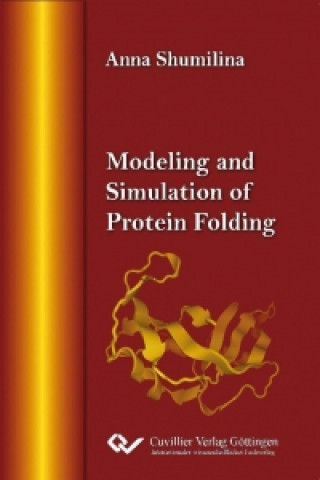
Dostawa
Doradca ds. zakupów
16 131 539 książek w 175 językach







Pokaż wszystkie języki (175)





Jednak się nie przyda? Nic nie szkodzi! U nas możesz zwrócić towar do 30 dni
 Bon prezentowy
O dowolnej wartości
Bon prezentowy
O dowolnej wartości
Bon prezentowy to zawsze dobry pomysł. Obdarowany może za bon prezentowy wybrać cokolwiek z naszej oferty.
Modeling and Simulation of Protein Folding
 Angielski
Angielski
 112 b
112 b
30 dni na zwrot towaru
Mogłoby Cię także zainteresować


The book describes a new mathematical model for intracellular protein folding and the implementation of this model in the form of a novel simulation software. Besides, the related biological, chemical, and physical background, important for understanding and rationalization of the proposed model, is outlined, and a short overview of the best-known methods for protein structure prediction and molecular modeling is given.The first chapter provides a general introduction to the problem, characterizes the chemical structure of proteins, and summarizes amino acid properties, including chirality and ionization behavior. After that, the principles of quantum mechanics and their consequences for the molecular structure are described. The discussion goes over to covalent and hydrogen bonding, as well as to electrostatic and van der Waals interactions. Further, some known facts about the three-dimensional structure of proteins and typical conformations of amino acids are outlined, followed by a quick glance at the hydrophobic effect and the interaction of charged groups with the solvent. Later on the focus is shifted to biological aspects, starting with chaperons and assisted protein folding, mentioning prions, which put into question the popular hypothesis about the global energy minimum of any native structure, and continuing with details of protein synthesis in the cell, which constituted the basis for the proposed model. The chapter finishes with a short description of experimental methods for protein structure prediction and with some information about databases for storage of known protein structures.The second chapter starts with a short overview of the knowledge-based protein structure prediction and ab initio protein folding approaches, then continues with empirical molecular mechanics force fields, typically used for molecular modeling. After that, it describes computation of atomic partial charges with a focus on the procedure of J. Gasteiger and M. Marsili, and proceeds with some models for hydrogen bonding. The chapter ends with a discussion about implicit solvation models.The third chapter describes the new modeling approach and some mathematical theory developed in relation to it. The idea of the model is to simulate a process resembling intracellular cotranslational folding. An attachment of a new residue is performed in a way that the formed peptide group is disposed in the trans conformation, and only the chain twisting about certain single bonds is allowed. Transitions with an energy increase are permitted to a limited extent. Beside the electrostatic and van der Waals interactions, the proposed model incorporates hydrogen and disulfide bonding, solvation effects, and dielectric screening at the protein surface. A general expression connecting interatomic distances and dihedral angles is derived, which resulted in a formulation of the model in the space of molecular torsion angles. Twisting forces are computed analytically and utilized for the improvement of computational efficiency the folding simulations. Besides, equations for dynamics in the space of torsion angles are derived, and a conclusion related to folding pathways is drawn.The last chapter discusses some non-technical details related to the implementation of the proposed model, including a number of developed algorithms, and the resulting simulation software. The chapter ends with a short discussion of simulation results and with an outlook.This book is aimed in the first place to biophysicists and bioinformaticians, but can be also interesting for theoretical chemists, mathematicians, and molecular biologists, since it includes a broad interdisciplinary overview accompanied by unique visualizations, which were performed with the help of the simulation software developed by the author.
Informacje o książce
 Angielski
Angielski




 Jak kupować
Jak kupować




















